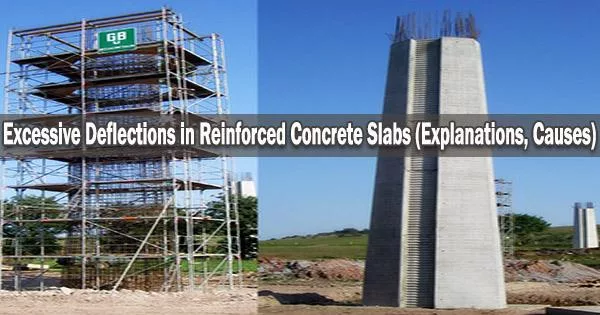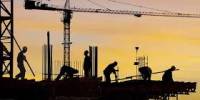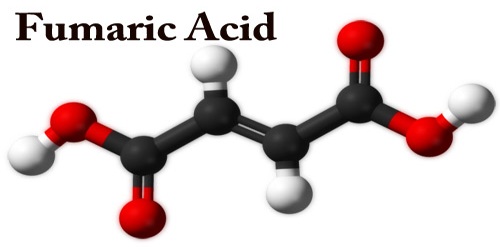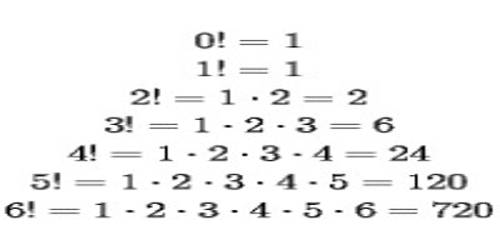Reinforced concrete slab deflection is permitted up to a particular limit that is defined by applicable codes such the ACI, IS, and Euro codes. These codes describe the permissible level of deflection. When the deflection limit is exceeded, it may result in a number of concerns, including aesthetic issues, tenant discomfort, the development of cracks in the walls, and occasionally the malfunction of doors and windows.
An adjacent balcony may sag inward as a result of excessive deflections in reinforced concrete slabs. Because rainwater that falls on the balcony will go inside the building and may harm the building’s contents, this is extremely hazardous and unacceptable. This is one of the key elements that contribute significantly to the importance of preventing excessive deflection of reinforced concrete slabs.
There are many reasons why reinforced concrete slabs deflect excessively, and any one of these reasons alone or in combination with others could produce a deflection that exceeds safe limits. Understanding the root of the issues, which will be discussed in the next sections, is the best method to prevent excessive deflection. Only after that could appropriate remedies be suggested.
Causes of Excessive Deflections in Reinforced Concrete Slabs –
Following are the different causes responsible for excessive deflections in RCC slabs:
- Design of reinforced concrete slab
- Material properties used in the reinforced concrete slab
- Construction of reinforced concrete slab
- Change the function of the reinforced concrete slab
- Environmental conditions
Design of the Reinforced Concrete Slabs
Generally speaking, excessive deflection can be caused by both the thickness of a reinforced concrete slab and the slab’s reinforcement ratio. Because of this problem, applicable codes like the ACI Code require a minimum slab thickness to keep deflection within a reasonable range even though choosing a thin slab can be adequate in terms of strength.
Similar to the previous example, if the computed reinforcement ratio is low, it will eventually give, significantly reducing the slab’s flexural stiffness until finally causing a sizable amount of deflection.
Material Properties Used in Reinforced Concrete Slabs
According to reports, one of the factors that contribute to significant deflection is anomalous creep and shrinkage of the materials used in the slab construction. When using high strength concrete, there might occasionally be significant shrinkage, which is likely to contribute to significant deflection. Alkali aggregate reactions, it should be noted, also had a negative impact on the deflection of reinforced concrete slabs because they cause the initiation of cracks, which ultimately cause a decrease in flexural stiffness and an increase in deflection.
Construction of Reinforced Concrete Slabs
If built improperly, a number of constructional features may result in excessive deflection. For instance, big panels and cantilevers will experience significant deflections if they are improperly cambered during construction. If curing is not carried out properly, the slab won’t be able to develop the necessary strength and will afterwards deflect significantly. The top reinforcement of the slab during construction is probably pushed down by workers. As a result, the improvement in flexural stiffness afforded by reinforcing continuity at supports will be significantly reduced. This reduces the effective depth.
RCC Slab at its early life may crack largely and its stiffness decreases largely because of construction loads imposed by storage materials or propping. When a slab is being built and supported by props, if the prop is mounted on a plate with insufficient surface area to prevent ground settlement, the slab will sag as the prop moves closer to the ground.
It is important to note that deflection caused by a reduction in the effective depth of the top reinforcement is very common, and it has been suggested that going from a 20 cm effective depth to a 17 cm effective depth can lower flexural stiffness by more than 20%. Therefore, it is important to pay attention to construction loads since, if they are not handled appropriately, they may significantly impact the element’s deflection.
Change in Function of Reinforced Concrete Slabs
The purpose for which a reinforced concrete slab is typically designed is known, and it is for this purpose that the elements’ strength and usability are evaluated. However, the slab can deflect significantly if its purpose is altered and the applied loads, particularly permanent loads, are increased.
Environmental conditions of Reinforced Concrete Slabs
A reinforced concrete slab is more prone to deflect unexpectedly if it is exposed to external factors like temperature changes that could create a temperature gradient.
















